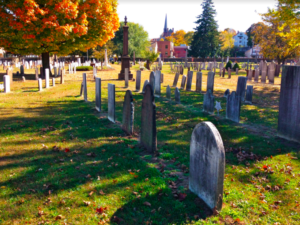With Halloween fast approaching, many Wallingford houses are decked out in synthetic cobwebs, inflatable monsters, and plastic gravestones. But what many students and residents may not know is that Wallingford has a much stronger link to the supposed supernatural. Buried in the Center Street Cemetery is a woman accused of practicing witchcraft in the mid 1700s.
Historians agree that one of the darkest periods of New England history came in the form of the 17th-century witchcraft trials and persecutions. The most widely known series of these events is the Salem Witch Trials, in which, beginning in 1692, over 200 people were accused of witchcraft, and 19 were hanged for the deed. Witch trials were not exclusive to Salem, Massachusetts. The entirety of the New England colonies was home to a multitude of witchcraft accusations and trials. As it happened, New England’s final witch trial took place in Wallingford. It placed two women — Mrs. Winifred King Benham and her daughter, Ms. Winifred Benham Jr. — in front of the court.
The members of the Benham family were some of the first settlers in Wallingford. Mr. Joseph Benham, Mrs. Benham’s husband, has his name engraved in a plaque on Center Street commemorating the founders of Wallingford. The family of 14 secured a six-acre home lot. They lived quietly for about a decade.
But then the Benham’s reputation became tainted. Mr. Benham was allegedly thought to have criticized local magistrates, an offense that brought him in front of the New Haven court. The Wallingford townspeople began to gossip about the Benhams, and, in 1692, rumors started to circulate specifically about Mrs. Benham.
Ms. Cynthia Wolfe Boynton, author of Connecticut Witch Trials, explained that a local named Goodwife Hannah Parker was the first to accuse Mrs. Benham of practicing witchcraft, after Mr. Benham, for reasons that remain unclear, threatened to “load his gun with two bullets and use them both” on Ms. Parker. Tensions simmered for five years, and, in in 1697, Mrs. Benham and her 13-year-old daughter were more formally accused.
This time, the accusers were local teenagers who belonged to respectable families of Wallingford. Mr. John Moss, Mr. Samuel Lathrop, Ms. Elizabeth Lathrop, and Ms. Sarah Clark claimed that the women inflicted bodily harm upon them, and they had the dark spots on their skin to prove it. Around the time of this accusation, an infant in town, died. The teenagers claimed that the child had dark spots, too, and so did Mrs. Benham and her daughter.
The Benhams were brought before a grand jury in Hartford. Mrs. Benham and Ms. Benham Jr. were searched for the “witch spots” and are said to have been thrown into water with rocks tied to their feet, to see if they could stay afloat, an eerie feat attributed to witchcraft. Accounts of the event indicate that the women survived this experience, but were not condemned, possibly because Connecticut had recently changed its standards for determining witch-hood.
The women were eventually acquitted, and the case was dismissed. Still, the Benhams reputation suffered immensely. The family’s once stable existence within the town, already shaken by Mr. Benhams earlier misdeeds, was further disrupted by the townspeople’s dislike for the Benham family women. Before long, the family relocated to New York after the trials.
And yet the Benhams seemed to feel that Wallingford was their home in the end. Mrs. Benham is buried in the Center Street Cemetery, about a mile from the Choate campus. America’s last witch trial continues to haunt her. She is still known today as the Witch of Wallingford.





